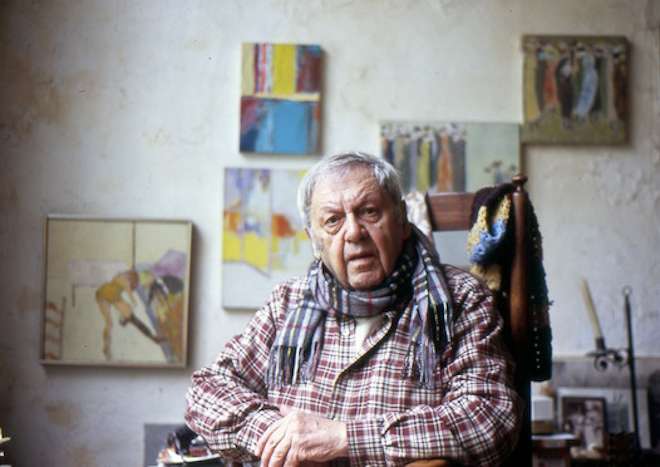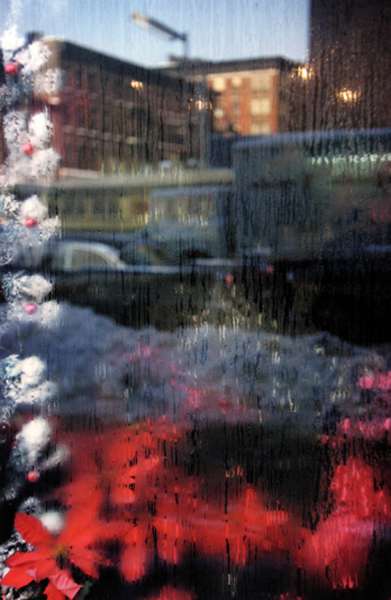 SAUL LEITER IN IN NO GREAT HURRY. . .Portrait of a photographer
SAUL LEITER IN IN NO GREAT HURRY. . .Portrait of a photographer The subject of this short documentary, Saul Leiter, the late New York color street photographer (he died a few days short of ninety, on November 26, 2013, just after this film had debuted at the Doc NYC film festival), objects repeatedly (doth he protest too much?) to being the subject of a film. And he may have been right. You would do much better to look at Leiter's photographs, a good selection of which can easily be found
online. Leiter lived for many decades in the same little apartment that he owned in the East Village. We see him, in his late eighties, photographed by Englishman Tomas Leach, who made this film, rambling in that neighborhood, among brownstones and small parks, making photographs. Though some of his best work was undoubtedly made in the Fifties, Leiter, who in recent years, shortly before his death, became the subject of several books and gained international fame, never lost his distinctive eye or stopped taking photographs.
He owned another apartment occupied by his longtime companion, Soames Bantry, a former model, who died about a decade ago. In the early Fifites Edward Steichen chose some of his work to show in an exhibition at the Museum of Modern Art. That aroused jealousy among some of his peers, he says. Ironically, because he didn't seek fame, and repeatedly points to greater photographers who in his view deserve it far more. This modesty enabled him to work for many years in obscurity, a situation useful for many photographers, but one that particularly suits his personality and his style.
Leiter was the son of an orthodox rabbi in Pittsburgh who he says was "more interested in intellectual achievement than human kindness." Despite a host of relatives dead in the Holocaust, he offended the father by saying "I refuse to be a professional Jew." (Leiter often chuckles at his own jokes, which makes him seem a cross between witty and batty.) Though he is tended by a young admirer and assistant, Margit Erb, whom we see sifting through the mess and filing the work, Leiter admits he himself never organized it properly, and one can only hope that funds and personnel will be found to sift and file further, leading to a permanent collection and posthumous exhibitions and books.
Leiter says a great deal about his career, or the lack of it. He began as a painter, as is obvious. Oddly we're never directly shown any of his paintings, but his comment that Soames loved Bonnard is no surprise. Though not lacking in signage, hard edges, and people, the photographs maintain a light, delicate, abstract impressionist quality. Where others found kitsch, social comment, or ugliness, he found beauty and subtlety. It's also not surprising that Leiter first flourished in the age of De Kooning, whom he saw on the street, but refused to have his picture taken. He knew some important artists and photographers of his time but was close to few of them; he mentions with fondness Robert Capa and W. Eugene Smith. He was friends with the painter Richard Pousette-Dart, who with Smith pushed him to pursue photography. He was connected with Robert Frank and Diane Arbus.
In the photographs Leiter usually approaches any formal "subject" crabwise, a figure often in a corner or half hidden, a sunny tan nude in the country (Soames, we presume) filtered through a screen or dappled with shadow. Much use is made of objects seen through moisture on glass, reflected blurs, natural, found filters. Snow, frost, and fog came in handy and umbrellas add a light touch. Misery, he said, was not more important than happiness. Color is, of course, essential, often a matter of one bright touch. Clearly Leiter uses New York streets very differently from most other photographers of his generation. For that reason among others, it seems unwise to rank him against or above them, as some insist on doing. Suffice it to say that he was distinctive and very fine.
Leiter saw no harm in making money with his work, which he did through fashion photography in the Fifties, notably for Henry Wolf at
Harper’s Bazaar. Examples of it show how remarkably he maintained his distinctive style on the slick pages, as did others like Irving Penn, Richard Avedon, and Duane Michals. The film shows that Leiter has a good dealer, and large prints are made of his work, which in his heyday, though he adopted digital cameras latterly, was done on color slides. There are three main books, but also catalogues.
Still, Leach's film, in which the monologue becomes repetitious at times, is doomed to seem to those who don't know or pursue the work, to be just "an old man in a dry month," a rambling rumble of a "Gerontion" as Leiter, uneasy with questions, sips coffee, ruminates, fidgets with his hat and scarf, and rummages around in the chaos of his room piled at the edges with jumbles of old boxes full of photographs and slides. Occasionally we see Leiter's cozy cat. The 13 divisions may be necessary to create a sense of order, but they have no great specific point. As one who discovered Saul Leiter's very sympathetic work only in the past few years, I was delighted to learn of this film and I watched it with great interest. If I was a little disappointed, it is no fault of the young London-based Leach that he stays scrupulously out of the way, except for letting the camera shake a few times too often.
In No Great Hurry; 13 Lessons in Life with Saul Leiter, 75 mins., debuted at Doc NYC in Nov. 2013 and was opened theatrically in New York by the Film Society of Lincoln Center at the Elinor Bunin Center 3 Jan. 2014, where it was screened for this review. The film was partly funded by Leiter's New York dealer, the Howard Greenberg Gallery.
A recent thread in
The Online Photographer includes various followup links related to Leiter including a
New Yorker online piece by Teju Cole.

Saul Leiter, "Christmas"





